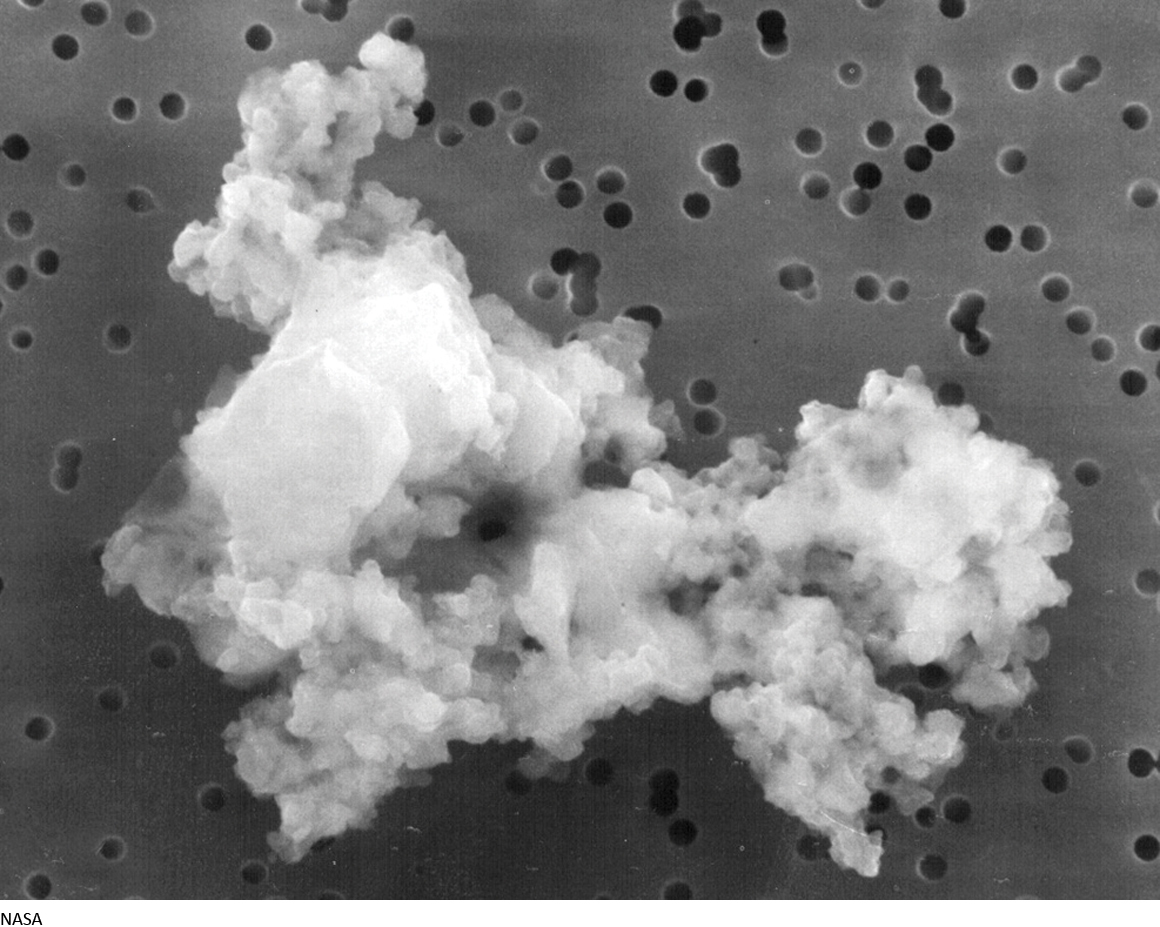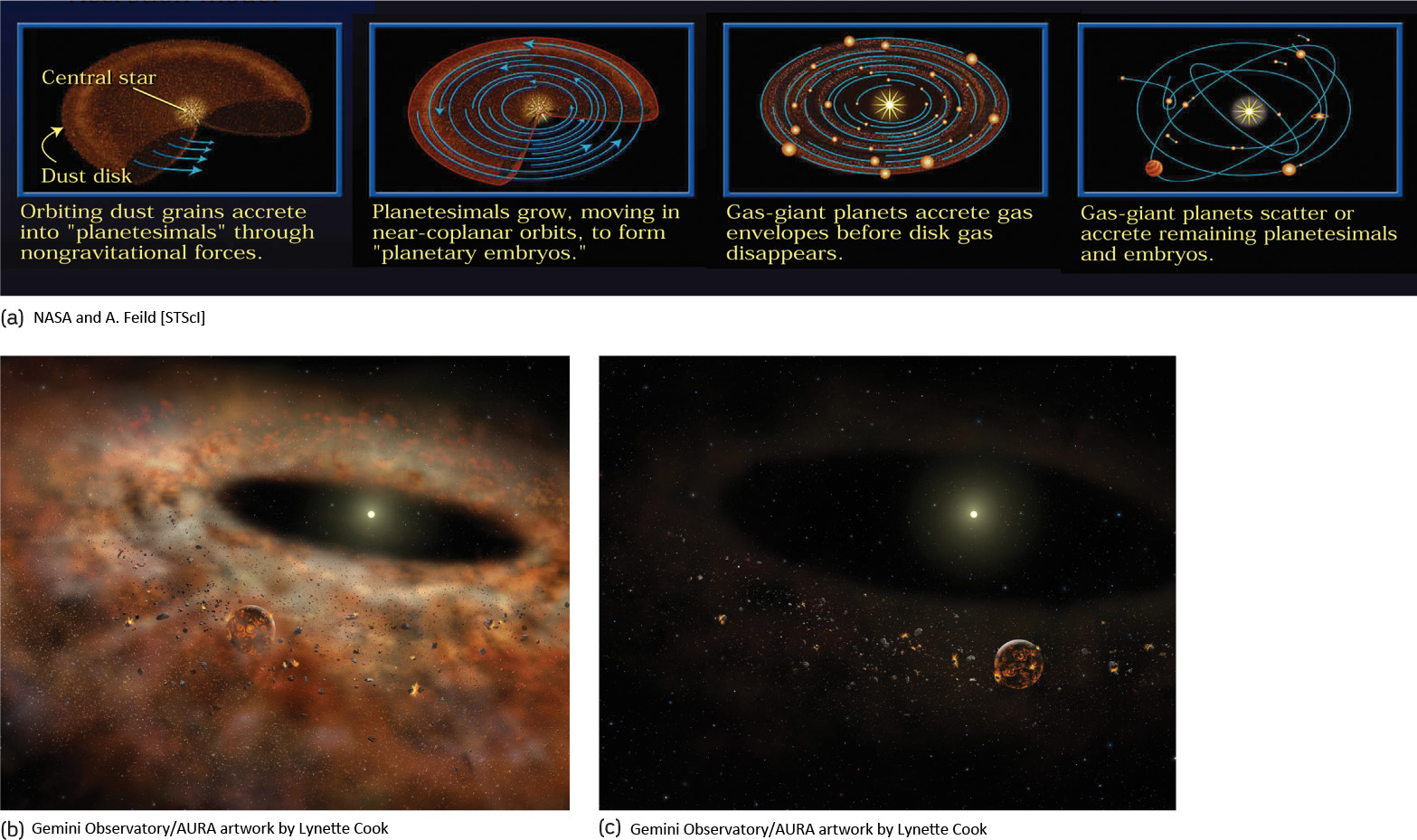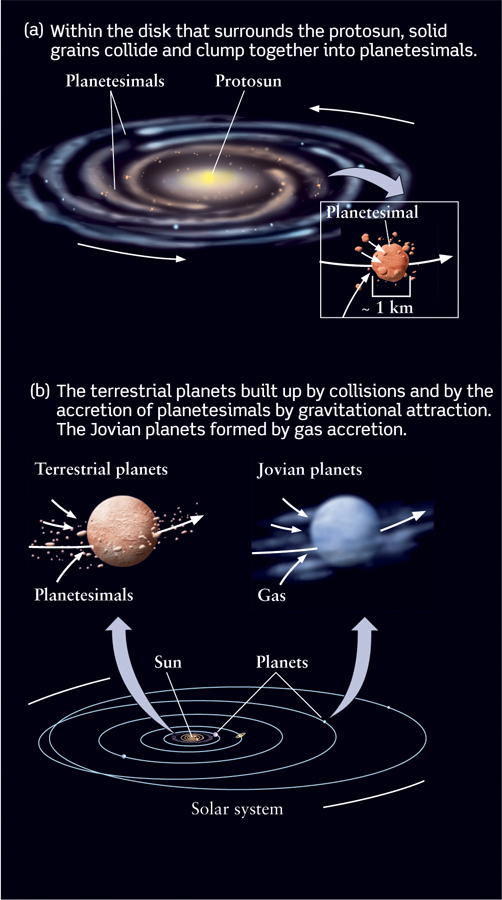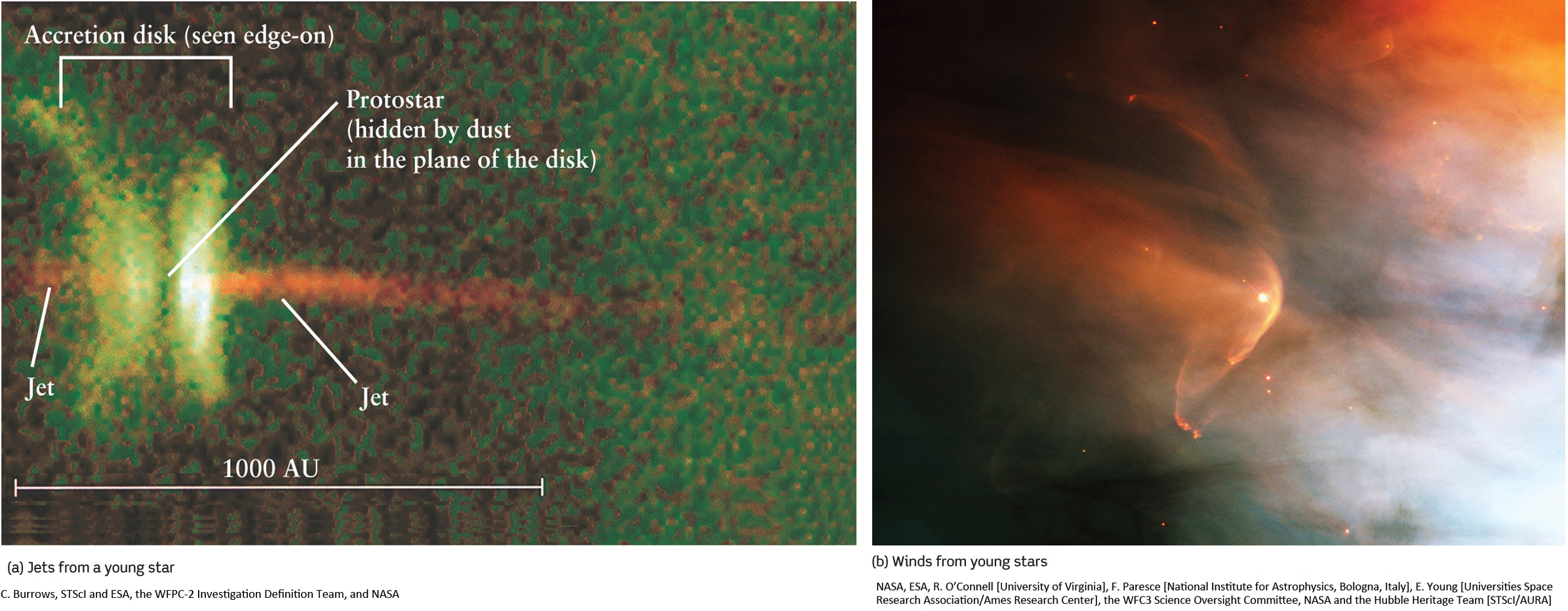4-6 The planets formed by countless collisions of dust, rocks, and gas in the region surrounding our young Sun
We have seen how the solar nebula would have contracted to form a young Sun with a protoplanetary disk rotating around it. But how did the material in this disk form into planets? And why are rocky planets in the inner solar system, while the giant Jupiterlike planets are in the outer solar system? If the nebular hypothesis is to be considered accurate, it needs to be able to successfully provide answers to these overarching questions.
Temperatures in the Solar Nebula
To understand how the planets, asteroids, and comets formed, we must look at the conditions that prevailed within the solar nebula. The density of material in the part of the nebula outside the protosun was rather low, as was the pressure of the nebula’s gas. If the pressure is sufficiently low, a substance cannot remain in the liquid state, but must end up as either a solid or a gas. For a given pressure, what determines whether a certain substance is a solid or a gas is its condensation temperature. If the temperature of a substance is above its condensation temperature, the substance is a gas; if the temperature is below the condensation temperature, the substance solidifies into tiny specks of dust or snowflakes. You can often see similar behavior on a cold morning. The air temperature can be above the condensation temperature of water, while the cold windows of parked cars may have temperatures below the condensation temperature. Thus, water molecules in the air remain as a gas (water vapor) but form solid ice particles (frost) on the car windows.
Planets form as a natural by-product of the formation of stars from the collapse of a giant interstellar cloud of dust and gas.
Substances such as water (H2O), methane (CH4), and ammonia (NH3) have low condensation temperatures, ranging from 100 K to 300 K. Rock-forming substances have much higher condensation temperatures, in the range from 1300 K to 1600 K. The gas cloud from which the solar system formed had an initial temperature near 50 K, so all of these substances could have existed in solid form. Thus, the solar nebula would have been populated by an abundance of small ice particles and solid dust grains like the one shown in Figure 4-13. (Recall that “ice” can refer to frozen carbon dioxide, methane, or ammonia, as well as frozen water.) But hydrogen and helium, the most abundant elements in the solar nebula, have condensation temperatures so near absolute zero that these substances always existed as gases during the creation of the solar system. You can best visualize the initial state of the solar nebula as a thin gas of hydrogen and helium strewn with tiny dust particles.

 Go to Video 4-2
Go to Video 4-2
Figure 4-14 shows the probable temperature distribution in the solar nebula at this stage in the formation of our solar system. In the inner regions of the solar nebula, water, methane, and ammonia were vaporized by the high temperatures. Only materials with high condensation temperatures could have remained solid. Of these materials, iron, silicon, magnesium, and sulfur were particularly abundant, followed closely by aluminum, calcium, and nickel. (Most of these elements were present in the form of oxides, which are chemical compounds containing oxygen. These compounds also have high condensation temperatures.) In contrast, ice particles and ice-coated dust grains were able to survive in the cooler, outer portions of the solar nebula.

Question
ConceptCheck 4-13: How might the solar system be different if the location at which water could freeze in the solar nebula was much more distant than it was in the solar nebula that formed our solar system?
103
Planetesimals Become Protoplanets, Then Rocky Planets
In the inner part of the solar nebula, the grains of high-condensation-temperature materials would have collided and merged into small chunks. Initially, electric forces—that is, chemical bonds—held these chunks together, in the same way that chemical bonds hold an ordinary rock together. Over a few million years, these chunks coalesced into roughly 109 asteroidlike objects called planetesimals, with diameters of a kilometer or so. These were large enough to be held together by the gravitational attraction of the different parts of the planetesimal for each other. During the next stage, gravitational attraction between the planetesimals caused them to collide and accumulate into still-larger objects called protoplanets, which were roughly the size and mass of our Moon. This process of accumulation of material to form larger and larger objects is called accretion. During the final stage, these Moon-sized protoplanets collided to form the inner planets. This final episode must have involved some truly spectacular, world-shattering collisions.
In the inner solar nebula only materials with high condensation temperatures could form dust grains and hence protoplanets, so the result was a set of planets made predominantly of materials such as iron, silicon, magnesium, and nickel, and their oxides. This is just the composition of the present-day inner planets. We now understand that the accretion process only requires roughly 108 (100 million) years to form four or five rocky planets with orbits between 0.3 AU and 1.6 AU from the Sun.
Figure 4-15 illustrates how planetary systems evolve around a forming star. At first the material that coalesced to form protoplanets in the inner solar nebula remained largely in solid form, despite the high temperatures close to the protosun. But as the protoplanets grew, they were heated by the violent impacts of planetesimals as well as the decay of radioactive elements such as uranium, and this heat caused melting. Thus, the terrestrial planets began their existence as spheres of at least partially molten rocky materials. Material was free to move within these molten spheres, so the denser, iron-rich minerals sank to the centers of the planets while the less dense silicon-rich minerals floated to their surfaces. This process is called chemical differentiation. In this way the rocky planets developed their dense iron cores.

Because the materials that went into the terrestrial planets are relatively scarce, these planets ended up having relatively small mass and hence relatively weak ability for gravitational attraction. As a result, the terrestrial protoplanets were unable to capture any of the hydrogen or helium in the solar nebula to form atmospheres. The thin envelopes of atmosphere that encircle Venus, Earth, and Mars evolved much later as trapped gases escaped from the molten interiors of these planets.
Question
ConceptCheck 4-14: How do rocky planets develop a core that has a higher density than rocks on their surfaces?
104
Outer Planet Formation by Core Accretion: Capturing an Envelope of Gas
Like the inner planets, the outer planets may have begun to form by the accretion of planetesimals. The key difference is that ices as well as rocky grains were able to survive in the outer regions of the solar nebula, where temperatures were relatively low (see Figure 4-14). The elements of which ices are made are much more abundant than those that form rocky grains. Thus, much more solid material would have been available to form planetesimals in the outer solar nebula than in the inner part. As a result, solid objects several times larger than any of the terrestrial planets could have formed in the outer solar nebula. Each such object, made up of a mixture of ices and rocky material, could have become the core of a Jovian planet and served as a “seed” around which the rest of the planet eventually grew.
Thanks to the lower temperatures in the outer solar system, gas atoms (principally hydrogen and helium) were moving relatively slowly and so could more easily be captured by the strong gravity of these massive cores. Thus, the core of a Jupiterlike protoplanet could have captured an envelope of gas as it continued to grow by accretion. This picture is called the core accretion model for the origin of the outer planets.
Calculations based on the core accretion model suggest that both rocky materials and gas slowly accumulated for several million years, until the masses of the core and the envelope became equal. From that critical moment on, the envelope pulled in all the gas it could get, dramatically increasing the protoplanet’s mass and size. This runaway growth of the protoplanet would have continued until all the available gas was used up. The result was a huge planet with an enormously thick, hydrogen-rich envelope surrounding a rocky core with 5 to 10 times the mass of Earth. This scenario could have occurred at four different distances from the Sun, thus creating the four Jovian planets.
In the core accretion model, Uranus and Neptune probably did not form at their present locations, about 19 AU and 30 AU from the Sun, respectively. The solar nebula was too sparse at those distances to allow these planets to have grown to the present-day sizes. Instead, it is thought that Uranus and Neptune formed between 4 AU and 10 AU from the Sun, but were flung into larger orbits by gravitational interactions with Jupiter. Figure 4-16 summarizes our overall picture of the formation of the terrestrial and Jovian planets.

Question
ConceptCheck 4-15: Why would it be unlikely that the most distant, Jupiterlike planets of Uranus and Neptune formed by core accretion at their current locations?
The Final Stages of Solar System Evolution
While the planets were forming, the protosun was also evolving into a full-fledged star with nuclear reactions occurring in its core. The time required for this to occur was about 108 years, roughly the same as that required for the formation of the terrestrial planets. Before the onset of nuclear reactions, however, the young Sun probably expelled a substantial portion of its mass into space (Figure 4-17). Magnetic fields within the solar nebula would have funneled a portion of the nebula’s mass into oppositely directed jets along the rotation axis of the nebula, such as the jets shown in Figure 4-17a.

In addition, observations of our relatively unstable young Sun would have revealed it ejecting its thin outermost layers into space. This brief but intense burst of mass loss, observed in many young stars across the sky, is called a T Tauri wind, after the star in the constellation Taurus (the Bull) where it was first identified (an example of a wind-emitting star from the constellation of Orion is shown in Figure 4-17b). Each of the protoplanetary disks in Figure 4-12b (insets) has a similar wind-emitting T Tauri star at its center. (The present-day Sun also loses mass from its outer layers in the form of high-speed electrons and protons, a flow called the solar wind. But this is minuscule compared with a T Tauri wind, which causes a star to lose mass 106 to 107 times faster than in the solar wind.)
105
With the passage of time, the combined effects of jets, the T Tauri wind, and accretion onto the planets would have swept the solar system nearly clean of gas and dust. With no more interplanetary material to gather up, the planets would have stabilized at roughly their present-day sizes, and the formation of the solar system would have been complete. The figures in Cosmic Connections: Formation of the Solar System summarize our modern-day picture of the origin of our solar system. Prior to 1995 the only fully formed planetary system to which we could apply this model was our own. As we will see in the next section, astronomers can now further test this model on a rapidly growing number of planets known to orbit stars other than our own.
Question
ConceptCheck 4-16: What are three processes that would have cleaned the early solar system of dust and gas?